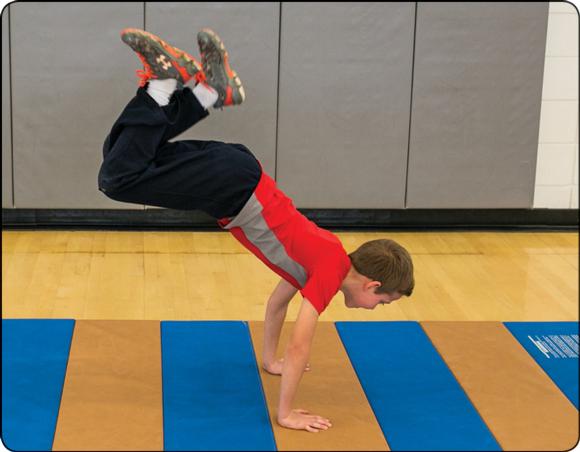Stability Skills: Step-Like Actions
This is an excerpt from Development Physical Education for All Children 5th Edition With Web Resource by Frances Cleland Donnelly,Suzanne S. Mueller,David L. Gallahue.
Use Table 16.4 as a resource for designing transference of weight - step-like action skill challenges. Examples are provided below the table.

The learning outcomes in step-like actions all help develop upper-body strength. Specifically, weight is transferred momentarily from the feet and hands to the arms, which strengthens the muscles in the back, trunk, and arms. Learning to perform the step-like movements is the goal of national physical education standard 1, and engaging in several repetitions in order to develop strength is the goal of standard 3. Assessments that address each goal appear throughout the tasks.
Learning Outcome
Gain greater consistency in the performance of step-like actions and variations.
- Standard 1: Transfer weight from the feet to different body parts and bases of support for travel (SHAPE America, 2014, p. 4)
- Standard 3: Use own body as resistance for developing strength (SHAPE America, 2014, p. 16).
Movement Concepts
- Body awareness: body part combinations
- Space awareness: level, pathway, distance
Teaching Styles
Reproduction: practice style with feedback about skill cues
Tasks
Task: Children perform the 3-legged dog walk, the bunny jump, and the mule kick to experience transferring weight momentarily from the feet and hands to only the hands and bringing the feet back to the starting position. In all skills, the emphasis is on moving the shoulders over the hands, keeping the arms straight, and transferring weight to the hands.
- Perform the 3-legged dog walk by raising one leg in the air from a starting position on two feet and two hands. Step forward on the hands and hop on the foot to travel as follows:
- For short to longer distances
- Along straight and curved pathways
- Along a bench or low beam
- Perform the bunny jump by starting from a crouch on two feet, reaching forward to place the hands on the mat, and jumping forward with the feet toward the hands. Continue the action as follows:
- For short to longer distances
- From poly spot to poly spot
- Along straight and curved pathways
- Along a low bench or beam
- Perform the mule kick by starting from a position on all fours with the hips raised, shifting the shoulders directly over the hands, keeping the arms straight as one leg swings up, then pushing off of the floor with the remaining foot to raise both feet above the hips with the knees bent. Bring the legs down together and land on both feet. Alternatively, first lowering the swing leg and then lowering the push-off leg, thus landing on one foot at a time so that both end up on the ground together.

Mule kick.
Environment: Use a single-station, single-task setup or a multiple-station, single-task setup. Students work in personal space, either responding to your cues or completing tasks on cards.
Equipment: mats, poly spots, hoops, ropes, floor tape
Practice: Use constant practice of skills, increasing the number of repetitions as strength develops. Vary practice among types of skills.
Skill cues:
3-legged Dog Walk (Continuous Action)
- Raise one leg high.
- Hand-step, hand-step, hop; repeat.
Bunny Jump (Continuous Action)
- Crouch.
- Put weight on hands.
- Jump toward hands.
Mule Kick
- From a crouch, raise hips.
- Position shoulders over hands.
- Swing one leg up.
- Push off and raise second leg.
- Land on both feet or on one foot and then other foot (swing foot comes down first).
Feedback
KPp: "Keep your elbows locked to make a solid base for taking weight."
Assessment
Standard 1: Use an observation checklist of skill cues for each animal walk (figure 16.13).
Standard 3: Keep records of traveling for longer periods of time, longer distances, or more repetitions.

SHOP

Get the latest insights with regular newsletters, plus periodic product information and special insider offers.
JOIN NOW
Latest Posts
- Authenticity was key to McKinney’s NIL success
- AI—A new tool for sport PR pros
- Essential skills for sport PR practitioners
- Employ these tactics when pitching a story to the media
- How does ergonomic analysis and intervention enhance safety and reduce injury risk?
- Common movement patterns in competitive cycling


